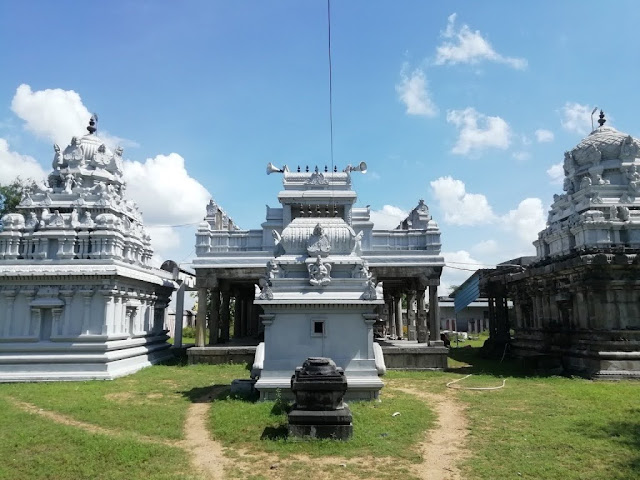Melakkoil Cave Temple,
Kudumiyanmalai – The Temple Complex
The rock cut cave temple complex consists of a rock cut cave shrine with structural mandapas in the front and two structural shrines. The rock cut cave temple is excavated on the eastern slope of low rising hillock and is facing towards east. The rock cut cave temple consists of sanctum, ardha mandapa, mukha mandapa and maha mandapa. The maha mandapa was built in a raised level and can be reached by flight of steps on the northern and southern side.
An inscription on the basement of the outer wall of the mandapa near the steps records that the mandapa was built by Raghunatharaya Thondaiman. Few Chola period fragment inscriptions and a miniature sculpture of Nataraja can be seen on the southern side of the exterior wall of the mandapa. Nandi can be found in the maha mandapa facing towards the sanctum. Sculptures of Somaskanda and Chandeswara can be seen in the maha mandapa.
The sanctum, ardha mandapa and mukha mandapa is excavated from the rock. The mukha mandapa is supported by two pillars and pilasters. The pillars of the mukha mandapa resemble early Chalukyan style. The ardha mandapa is wider than the mukha mandapa. The ardha mandapa has niches on its lateral walls. The niches are carved with images of dvarapalas. Both the dvarapalas are shown standing in tribhanga posture, with one hand at their waist and another resting over a huge club. Both are shown with a third eye over their forehead.
The southern dvarapala is shown wearing a yajnopavita while the northern is without it. There is a label inscription in Pallava grantha script on the southern lateral wall of the ardha mandapa. This inscription reads as parivadinida. It refers to a stringed musical instrument. It seems that the notes in the musical inscription would have been meant to be played on this musical instrument. A rock cut niche enshrining an image of Valampuri Vinayaga can be seen below this label inscription.
He is four armed with his trunk turned towards right. His two upper hands holds the broken tusk and lotus and one of his lower hand holds a modak and other lower hand rests over his waist. The western wall of the ardha mandapa is fully with inscriptions. The doorway to the sanctum is flanked by two pilasters. There are four Bhootaganas seen above the lintel of the sanctum door. Two ganas are in opposite direction just above the sanctum door, while the other two ganas are shown moving away are placed at the corners of the lintel.
All the four are depicted in flying
posture. The sanctum is situated slightly above the ground floor of the ardha
mandapa and can be reached after a flight of three steps. The sanctum is square
on plan. The sanctum enshrines the presiding deity, Thirumetrali Mahadevar in
the form of Linga housed in a square avudaiyar. The Linga and the avudaiyar was
excavated from the mother rock.
Soundaranayaki / Malai Mangai Amman Shrine:
This structural shrine is situated on the south side of the rock cut cave shrine. This shrine consists of sanctum, ardha mandapa and mukha mandapa. The mukha mandapa is a closed pillared structure with entrances on eastern, northern and southern side. The eastern and northern entrances were provided with steps, but the southern entrance is without steps. The sanctum enshrines an image of Soundaranayaki / Malai Mangai. She is shown in standing posture. She is four armed. The upper hands holds neelotpala & lotus and lower hands show varada and abhaya hastha. There are niches on the three sides of the sanctum walls. All the niches are empty.
Ganesha Shrine:
This structural shrine is situated on the on the northern side of the rock cut cave shrine. This shrine is facing towards east. It consists of sanctum and entrance porch. The sanctum enshrines an image of Vinayaga. He is shown seated on a pedestal in maharajalilasana. He is four armed. His lower hands holds modaka & tusk and upper hands holds the pasa & angusa.
Musical Inscription:
For brief details, please refer below link;
Idampuri Vinayaga:
There is a niche enshrining Idampuri Vinayaga can be seen immediately to the southern side of the celebrated musical inscription. He is four armed with his trunk turned towards left. His two upper hands holds the ankusa & pasa and one of his lower hand holds the broken tusk and the object on the other lower hand is not identifiable.
Bas relief images of 64 Nayanmars:
Bas relief images of 64
Nayanmars with Lord Shiva and Parvati seated on Nandi at the center can be
found above the cleft on the slope of the hillock. It is situated to the north
of the
cave temple. It is unusual to see the arrangement of Nayanmars in this
fashion as the images of 63 Nayanmars are generally seen in the prakara of
Shiva temples.
Inscriptions:
There are about forty-five inscriptions found in the rock cut cave temple. Out of 45, 26 inscriptions are found in the mukha mandapa and its pillars, 18 inscriptions are found in the walls of the mandapa and one inscription is found in the pilaster of the sanctum. Most of the inscriptions belonged to the Pallavas, Pandyas, Cholas and Thondaiman Kings.











.jpg)




.jpg)










